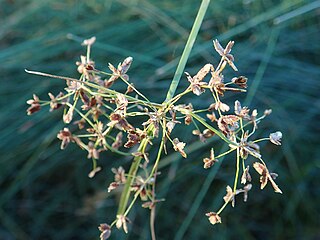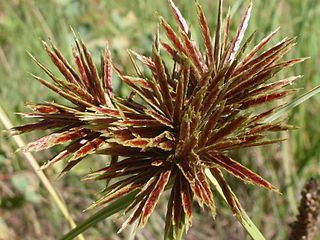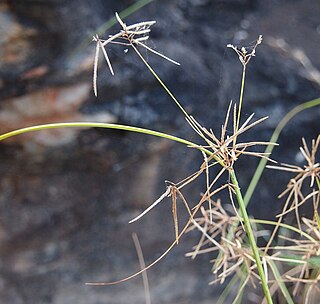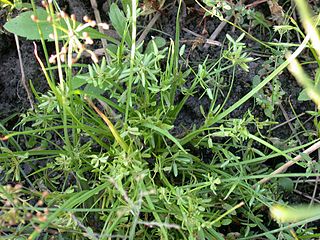
Cyperus polystachyos, also known as Pycreus polystachyos and commonly known as bunchy sedge, many-spiked sedge, or Texas sedge, is a herbaceous species in the family Cyperaceae, widespread in tropical and subtropical areas around the world, sometimes extending its range into temperate regions. In the United States, it has been reported from a region from Texas to Maine.

Cyperus alterniflorus, commonly known as umbrella flat-sedge, is a sedge of the family Cyperaceae that is native to Australia.

Cyperus compressus, commonly known as annual sedge, is a sedge of the family Cyperaceae that has a wide distribution throughout countries with warmer climates. It is found in tropical areas of Africa, Asia and the Americas.

Cyperus concinnus is a sedge of the family Cyperaceae that is native to Australia, and found in New South Wales, Queensland, the Northern Territory, South Australia, Victoria and Western Australia.

Cyperus congestus, commonly known as dense flat-sedge or clustered flat-sedge, is a sedge of the family Cyperaceae that is native to southern Africa mostly in South Africa, Lesotho and Namibia.

Cyperus dactylotes is a sedge of the family Cyperaceae that is native to Australia.

Cyperus flaccidus is a sedge of the family Cyperaceae that is native to Australia.

Cyperus gilesii, commonly known as Giles' flat-sedge, is a sedge of the Cyperaceae that is native to Australia.
Cyperus gymnocaulos, commonly known as spiny flatsedge, is a sedge of the family Cyperaceae that is native to Australia.

Cyperus javanicus, also known as the Javanese flatsedge, is a sedge of the family Cyperaceae that is native to Indonesia and Australia.
Cyperus latzii is a sedge of the family Cyperaceae that is native to Australia, and found in the Northern Territory and Western Australia.
Cyperus nutans is a sedge of the family Cyperaceae that is native to Australia, and to China, India, Bangladesh, south-east Asia, Malaysia, India, and Indonesia.
Cyperus pulchellus is a sedge of the family Cyperaceae that is native to northern Australia.
Cyperus rigidellus is a sedge of the family Cyperaceae that is native to Australia.
Cyperus surinamensis, also known as the tropical flatsedge, is a sedge of the family Cyperaceae that is native to the Americas.

Cyperus vaginatus, commonly known as stiff-leaf sedge or stiff flat-sedge, is a sedge of the family Cyperaceae that is native to Australia.
Cyperus victoriensis, also known as channel nut grass is a sedge of the family Cyperaceae that is native to Australia.
Cyperus viscidulus is a sedge of the family Cyperaceae that is native to north western Australia.
Cyperus vorsteri is a sedge of the family Cyperaceae native to southern Africa.
Cyperus dubius, the soft sedge, is one of around 700 species of Cyperus in the sedge family, Cyperaceae. It is found throughout in tropical Africa, South India, and Indo-China to Malesia. It is growing in seasonally flooded areas and in pockets of soil in rocks. It is not confined to wetlands and is sometimes found as a weed in fields and near in sea on sandy beaches and also seen in open shady places.










